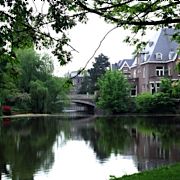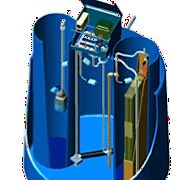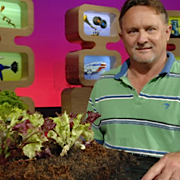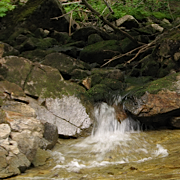This is the sixth and final article (part I, II, III, IV and V) in our series on Saving Water. Living in Sydney, Australia I’m acutely aware of the value of this precious resource.
Designing a new house? Great. This article looks at the many things you can do at this point which will radically reduce the amount of water you use – without adding anything at all to the total cost.

By how much can you reduce it? In many areas, it’s quite possible to disconnect from the mains supply altogether – or at least to stop using water from that source.
Let’s get started.
Water conservation can be broken into three broad areas. These are :
- reduce the amount you use
- collect your rainwater *
- re-use it where possible (clean it as necessary)
Looking at it this way, you’ll see that it isn’t a single problem to be addressed. Several small changes will have a major impact.
* I realise that this could be placed in the ‘re-use’ category, but it’s such a key change that it’s been given a category of its own.
Reduce the amount you use
There are a few ways to do this. The first is by changing your behaviour (brushing your teeth without the water running, using a bucket for the cold shower water); a second is by using more efficient appliances. Designing a new house gives you the perfect opportunity to do this.
When buying water-efficient appliances, be sure to find out if there are any rebates available in your area, and take full advantage of them. Unexpected income is always a nice feeling, and the extra cash may make the difference between a device that’s ‘OK’ and the one you really want.
The third way is a little less obvious. Almost any physical product you buy (a can of tomatoes, for example) will incur a fair amount of production, packaging, transportation and display. Purchasing an alternative product (or, in the case of tomatoes, growing your own) often reduces the cost of things, labour involved, power and water used. Of course it isn’t always possible – or even reasonable – to buy something else; but it can make quite a difference in the long run.
When designing your house, it’s a great opportunity to take advantage of this third approach. Although the savings involved with a can of tomatoes may be negligible, a change of housing materials or suppliers can reward you with a notable reduction. In fact, the first place you’ll notice it is often in your wallet.
For more on these approaches, see the article How to save water around your house.
Collect your rainwater
This one alone will have a massive impact on the amount of water you purchase – and the home-design stage is the perfect time to really take advantage of it. In an earlier article we looked at the various types of water tanks; all are great, however some of them are much more realistic when building a new home.
Particularly the bladder and wall tanks. Designing a deck to fit around a tank (rather than squeezing a tank into the space available) is definitely the way to go. Much, much cheaper.
In fact, you’ll probably be able to collect much more rainwater in a new home than an existing one of the same size. How much should you collect? Quite simply, as much as you can.
For more on this, see the article the benefits of using a water tank.
Re-use it where possible
Once again, there are a couple of approaches here. As with the section on ‘reduce the amount you use’, a few minor changes in behaviour can have a marked impact. Directing excess water from your washing machine on to the garden, using bathwater to ‘bucket flush’ the toilet.
When designing a new house, however, you can also take advantage of both greywater and blackwater recycling. As one of the largest costs with these systems is the plumbing, this is the perfect time to set things up.
Installing a greywater system
In the last article we looked at greywater – what it is, and how to use it. Several options were noted, ranging from small behavioural changes to complete systems to clean and re-use the water supply. When it comes to the design of a new house, there’s a great opportunity to take advantage of all of them; particularly the full recycling systems.
There are several available, and your decision will certainly come down to location and budget; however a good place to start is with the Nubian Oasis.
For more on this, see the article Using Greywater.
Blackwater
 Blackwater is water which contains the waste from areas such as toilets and greasetraps; and accordingly needs quite a bit of cleaning before it can be re-used. The result is usually Class A+ water – the highest standard of recycled water possible. Although some regulations prevent you from drinking this water (and you’d be fine if you did), it’s perfectly OK for everything else.
Blackwater is water which contains the waste from areas such as toilets and greasetraps; and accordingly needs quite a bit of cleaning before it can be re-used. The result is usually Class A+ water – the highest standard of recycled water possible. Although some regulations prevent you from drinking this water (and you’d be fine if you did), it’s perfectly OK for everything else.
Currently there are only a handful of options when it comes to recycling residential blackwater; though I imagine this will greatly increase over the next few years. An example of a blackwater system that can be purchased right now is this one from EcoNova.
NB : as governments around the world have different viewpoints on equipment such as this, it’s worth asking a few questions of your local council or controlling body.
It isn’t just water you’ll be saving
 Throughout this series you may have noticed that in a number of cases, saving water also means saving time, money and electricity. An example of this is the KISSS roof garden system which was shown on the New Inventors a few days ago.
Throughout this series you may have noticed that in a number of cases, saving water also means saving time, money and electricity. An example of this is the KISSS roof garden system which was shown on the New Inventors a few days ago.
If you didn’t catch the show, the KISSS Ebb and Flow Mat provides an exceedingly simple and cost-effective way to manage a roof garden – even on sloped roofs. In addition to conserving water, the mats will greatly reduce the building’s heating costs (by around 30% for a typical home); as well as cutting back on the installation and maintenance times associated with rooftop gardening.
A brilliant idea.
Final thoughts on designing a water-efficient house
 I love water. Tipping your head back in a light snowfall, listening to a trickling stream, watching a fountain (thanks, Marty – this is a great idea), taking a cold shower on a hot day.
I love water. Tipping your head back in a light snowfall, listening to a trickling stream, watching a fountain (thanks, Marty – this is a great idea), taking a cold shower on a hot day.
Perhaps surprisingly, I also enjoy being surrounded by modern appliances. Fortunately, it’s quite possible to have both.
When designing your house, keep in mind that conserving water actually gives you greater control over your environment. Your bills will be lower, you’ll spend less time on maintenance and there’ll be absolutely no guilt whenever you decide to enjoy a long, hot shower or a soak in the bath.
Ideally, the amount of water your home collects from the rain will be enough to cover 100% of your water needs. In many parts of the world this is entirely possible – and will save you an incredible amount of money.
Designing a new house is the perfect opportunity to take full advantage of this possibility. Save money, help the environment; reduce your maintenance costs – perfect.
I hope this series has given you a couple of ideas when it comes to the topic of saving water. Self-sustainability (at least as far as water is concerned) really isn’t as difficult as you might think.
If you missed any of the previous articles, you can get up-to-speed below :